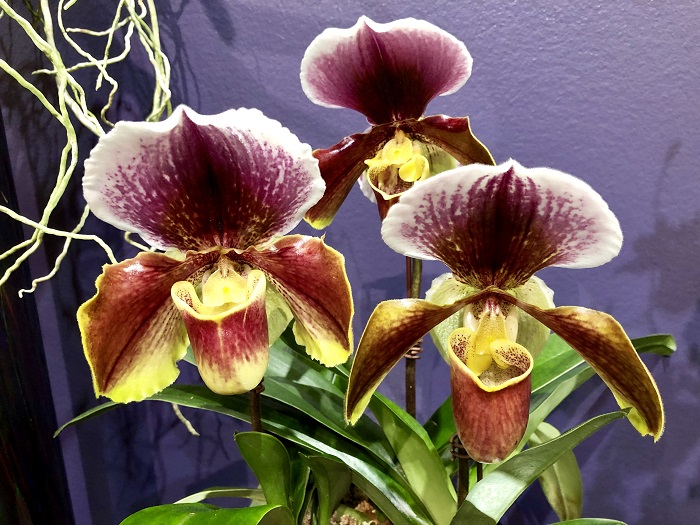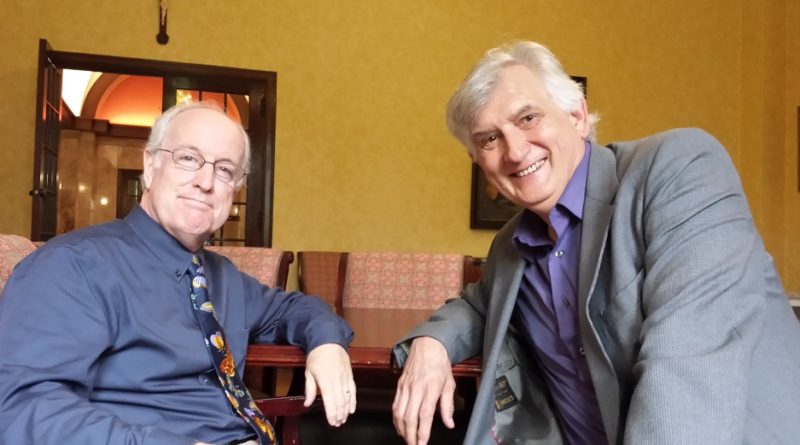Nature’s Best Hope Is You
Podcast: Play in new window | Download (Duration: 1:33:14 — 43.2MB)
Subscribe: Apple Podcasts | Spotify | Android | iHeartRadio | Podchaser | Email | TuneIn | RSS | More
(February 9, 2020) When I’m interviewing authors, I often put sticky tabs on their books’ best pages. So what happens when almost every page in a book has a sticky tab? That’s the problem I faced with Nature’s Best Hope: A New Approach to Conservation That Starts in Your Yard. The author, Douglas W. Tallamy, has been on my show several times, beginning in 2008, shortly after his book, Bringing Nature Home, was published.
Tallamy is a professor in the Department of Entomology and Wildlife Ecology at the University of Delaware. There, he teaches courses in insect taxonomy, behavioral ecology, humans and nature, and insect ecology.
I called his first book “game-changing.” I described him as a “horticultural zeitgeist rock star.” I explained how his book started a movement. All of it is true. Why? Because Tallamy revealed an important new way to assess the damage that we as a species are causing to our planet. It’s through our insect populations. As I wrote in 2012,
Tallamy explains in his book that when we use “alien” plants in our landscapes–that is to say, plants that come from other continents–we are failing to provide nourishment for our own native insects. Why? Because insects have spent tens of millions of years evolving with the plants around them and are either incapable of or not interested in consuming the alien species. As a result, birds, amphibians, lizards, fish and mammals who rely on insect populations to thrive have less food and see their populations decline.
Look at the landscapes around you and you might get some understanding of what I’m talking about. Plants like Norway maples, Callery pears, privet, oriental bittersweet, burning bush, English ivy, Japanese maples and even daylilies are not native to North America, and are not valuable food sources for insects.
Fast forward eight years to Nature’s Best Hope. Tallamy has expanded on the concepts he introduced in his first book. In 2007, he was more or less focused on what he could observe on his own property and on the east coast of the United States. After the book struck a chord and started getting attention, it was expanded in 2009. And Tallamy has continued to inspire a new generation of scientists and researchers who are running with his theories and are now backing them up with data.
For instance, in Nature’s Best Hope Tallamy writes about Kimberley Shropshire, his research assistant, who developed the Native Plant Finder for the National Wildlife Federation. The idea is that you can type in your zip code and find a list of native plants that are best for caterpillars that serve as food for birds in your immediate location. (Note: As of this writing, the link to this resource does not seem to be working.)
He has also backtracked from the word “alien.” He now calls those plants “introduced,” which I think is a good compromise. It explains how they got into our landscapes and natural areas. We (humans) introduced them. Ultimately, though, Tallamy asks, are “alien” or “introduced” plants bad? Can that pejorative be used? Yes, he concludes. And he explains why you need to make smart choices in your own yard.
Our environmental boat has sprung a leak. Many of us are trying to repair the leak; others are bailing to keep us afloat until the leak is plugged. What is baffling, though, is that far too many of us are dumping new buckets of water into our boat, as if sinking it will not be a problem for them. At this point, each of us must decide what role we will play in the future: Will you be a bailer or a dumper? Your choice of plants in your yard will determine what role you have chosen.
Are you looking in the mirror? I am. While I’m trying to be a bailer, I’ve been a dumper, too. As the song goes, it ain’t easy being green.
I’ve been thinking of alternative subtitles to his book. Here’s one. “Why you need to stop planting hostas, burning bushes, Callery pears, and butterfly bushes.” I gave up on burning bushes, and Callery pears years ago. but I still have a couple of hostas in the yard. And I can hear you saying, “But I love my burning bush!” My response to that, after reading Tallamy’s books is, “Well, what’s left of the ecosystem around your home doesn’t.”
The difference between Tallamy and me is that he’s an optimist. Note that he uses the word “hope” in his book title. He believes that we have the political will and resources to slow our march towards a sixth major extinction. Me? I’m not so sure. But he thinks that if we can transform the more than 40 million acres of lawn into something more ecologically sound, we have a chance.
His idea is that we create what he calls “Homegrown National Park.” It would involve every American landowner converting half of his or her lawn to native plants. Here’s why.
- Conservation that is confined to parks will not preserve species in the long run, because these areas are too small and too separated from one another.
- Although we must continue to protect good habitat wherever it still exists, we can no longer afford to ignore the ecological value of the land outside of our preserves–that is, the areas between isolated habitat fragments.
- Restoring habitat where we live and work, and to a lesser extent where we farm and graze, will go a long way toward building biological corridors that connect preserved habitat fragments with one another.
- Creating biological corridors will enlarge the populations of plants and animals within protected habitat, enabling them to weather normal population fluctuations indefinitely.
- Across the United States, millions of acres now covered in lawn can be quickly restored to viable habitat by untrained citizens with minimal expense and without any costly changes to infrastructure.
Doug Tallamy has changed the way I view our natural world. I preach his concepts as often as I can. Do I think that humans will embrace the miracle of native plants and insects and the importance of their relationships? Not really. At least not until it’s too late. But it would be irresponsible of all of us not to try.
By the way, Tallamy will be speaking on April 4 at the The Naturally Beautiful Conference, Sponsored by West Cook Wild Ones and Unity Temple ‘s Eco-Justice Team. The event is Saturday, April 4, 2020 from 1:00 PM – 4:30 PM at Unity Temple, 875 Lake Street, Oak Park, IL 60301.
Friends of The Mike Nowak Show Annamaria Leon and Ken Williams will also be speaking, so it’s going to be a great event.
Brilliance: The Orchid Show
It hasn’t been much of a winter in Chicago. No brutal cold. No paralyzing snow storms. I could actually get used to this.
On the other hand, there’s not much color in the winter world. Which is why you might want to head up to the Chicago Botanic Garden for The Orchid Show. It started on February 8 and continues through March 22. According to CBG,
 Brilliance: The Orchid Show will highlight and enhance the hues of 10,000 brilliant blooms in engaging and energizing ways that incorporate new materials such as chrome spheres and black bamboo. Attendees will experience bright shades of orchids, through floor-to-ceiling artistic installations including a towering canopy of color, a floating orchid carpet, and a dramatic chandelier filled with glistening blooms. The focus on color illuminates the brilliant survival strategies of wild orchids, which use color to attract their pollinators in order to reproduce.
Brilliance: The Orchid Show will highlight and enhance the hues of 10,000 brilliant blooms in engaging and energizing ways that incorporate new materials such as chrome spheres and black bamboo. Attendees will experience bright shades of orchids, through floor-to-ceiling artistic installations including a towering canopy of color, a floating orchid carpet, and a dramatic chandelier filled with glistening blooms. The focus on color illuminates the brilliant survival strategies of wild orchids, which use color to attract their pollinators in order to reproduce.
This morning, Jim Ault, Ph.D., Director of Ornamental Plant Research at the Chicago Botanic Garden, talks to us about the show. He is chair and manager of the Chicagoland Grows® plant introduction program, a corporate partnership of the Chicago Botanic Garden, the Morton Arboretum, and the Ornamental Grower’s Association of Northern Illinois, a network of wholesale nurseries located in northeastern Illinois. As it so happens, he’s also a bit of an orchid geek. He writes,
Yes, I do indeed grow orchids at home. I haven’t counted them recently, but I’d admit to 50-plus plants.
I simply find orchids to be fascinating for their seemingly infinite variations of flower sizes, shapes, colors, fragrance (very important to me!), and for their diverse ecological adaptations (epiphytes, terrestrials, lithophytes) and the resulting puzzle of how best to cultivate them. I first got interested in orchids in the 1970s, both from seeing some in the greenhouses at the University of Michigan, and also from visiting my grandmother in Miami. She was very active in the Florida fern society of the time, and had a backyard of ferns she grew from spores, with a smaller collection of orchids. She would send me home with plants on every visit, all of which I eventually lost, as I didn’t really have a clue as to how to grow them! But I was hooked, I think safe to say now, for life.
I would be remiss if I didn’t mention that Ault was also the Greenhouse Grower’s 2019 Industry Achievement Award Winner.
By the way, the Illinois Orchid Society Spring Show & Sale will be at the Chicago Botanic Garden on Saturday, March 14, 10 a.m. to 4 p.m., and Sunday, March 15, 9 a.m. to 4 p.m. Displays of orchids from the rarest of species to cultivated hybrids will be artistically arranged. Families can take part in orchid-based activities for children. Vendors will also be on-site to sell orchid plants and related products and Illinois Orchid Society members will offer repotting services.


